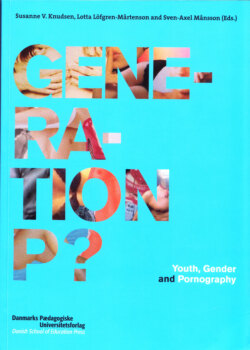Читать книгу Generation P? - Группа авторов - Страница 10
На сайте Литреса книга снята с продажи.
‘Porno-chic’ – sex and mainstreaming of pornography in mass culture By Anette Dina Sørensen
ОглавлениеWe give you adventurous days filled with sun, sand and real excitement as well as wild nights with j… (censored; read: juicy soda pop) score and sweaty hours (from an insertion on the front page of a catalogue put out by the Danish travel agency Øster Lindet in 2003).
Under the name Young Fun Tour, the Danish travel agency Øster Lindet (Eastern Lindet) arranges chartered trips to the south of Spain for adolescents. By studying the agency’s brochure, one gains an interesting picture of what the agency promotes as high-quality experiences for young people. As the quotation above suggests, there is to be a sufficient amount of alcohol, and high-quality travelling experiences are first and foremost about sex. The pictures in the catalogue conjure up unbridled excesses for those who have an urge to travel, and suggest how, where and with whom the sex drive can be satiated. The gender roles are obvious: while men are depicted as barflies who scan the surroundings and occasionally respond to ‘the goods’, the women are pictured as willing, enticing sirens with voluminous breasts and bulging nipples under wet, body-hugging T-shirts.
The women, presented as sexual offerings, apparently incarnate the alleviation that the travel agency implies will take place at the holiday destination. For potential male tourists, the women in the catalogue are presented as ‘a free choice’ guaranteed providers of sexual satisfaction. For the women who consider going to the south of Spain with Young Fun Tours, the catalogue’s holiday promise is that they are guaranteed to be selected – if they tend to their appearance and styling and, in addition, are willing to make themselves available.
The use of sex by mass culture to attract attention when targeting specified groups, (i.e., the aforementioned catalogue) is not a new phenomenon. In Denmark sexuality has legally been present in the public sphere since the relaxation of restraints on illustrated pornography in 1969. It was also possible to find mass cultural references to sex earlier, even though the regulations in § 234 in the Danish penal code about production and distribution of ‘indecent publications, illustrations or objects’often had the legal authorities screaming out loud(Thing 1999).
But although the phenomenon is not new, it has been commonly recognised in recent years that references to sex are now pervasive in the public sphere. Hence it is common – especially in public debate – to use the phrase ‘sexualisation of the public space’ (Cawood & Sørensen 2002, Krogh-Meyer 2002). While it is important to talk about the increasing extent to which mass culture refers to sexuality, what is new and more important is the imprint that pornography makes in mass culture and the way that sexualised mass culture portrays gender.
While in the 1990s, commercial illustrations, for example, depicted the postmodern decomposition of the traditional meanings of gender, there is today an increasing backslide toward quite traditional representations of gender. This is to be seen not only in commercial sales promotions, but also more generally as a common feature of fashion journalism, of youth magazines, of television programmes, of music videos and quite often in the campaigns the adolescents themselves initiate. These phenomena are related: the resurrection of stereotyped gender representations is closely connected to the onset of mass cultural pornography.
